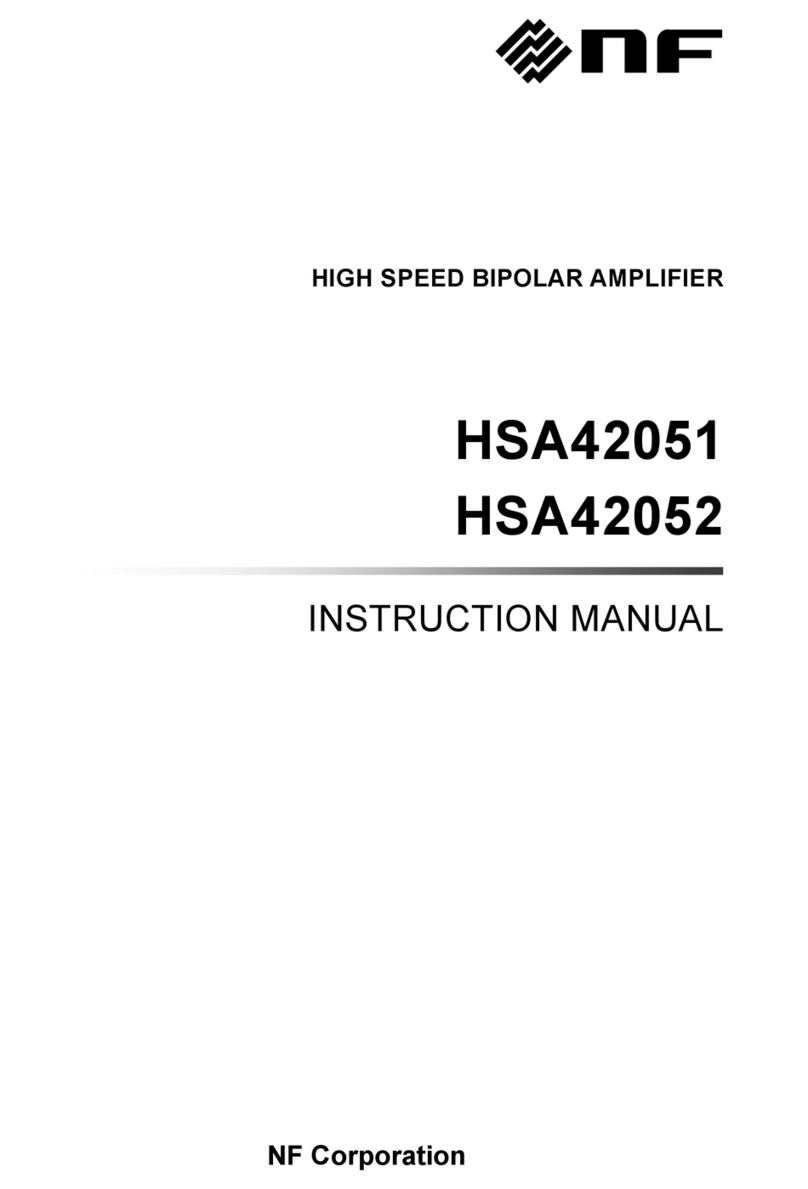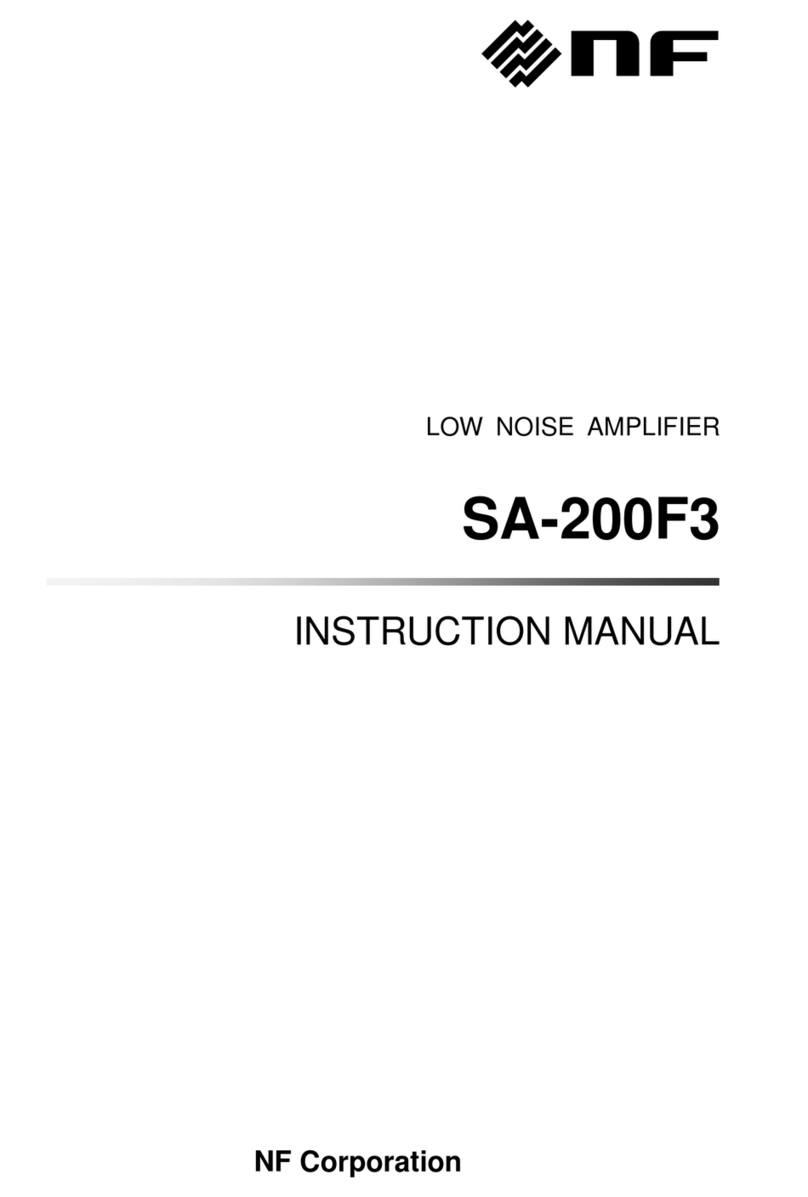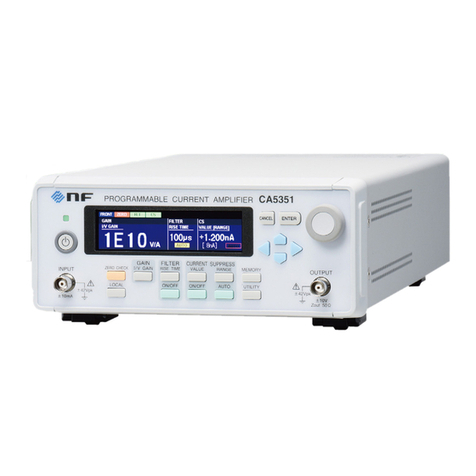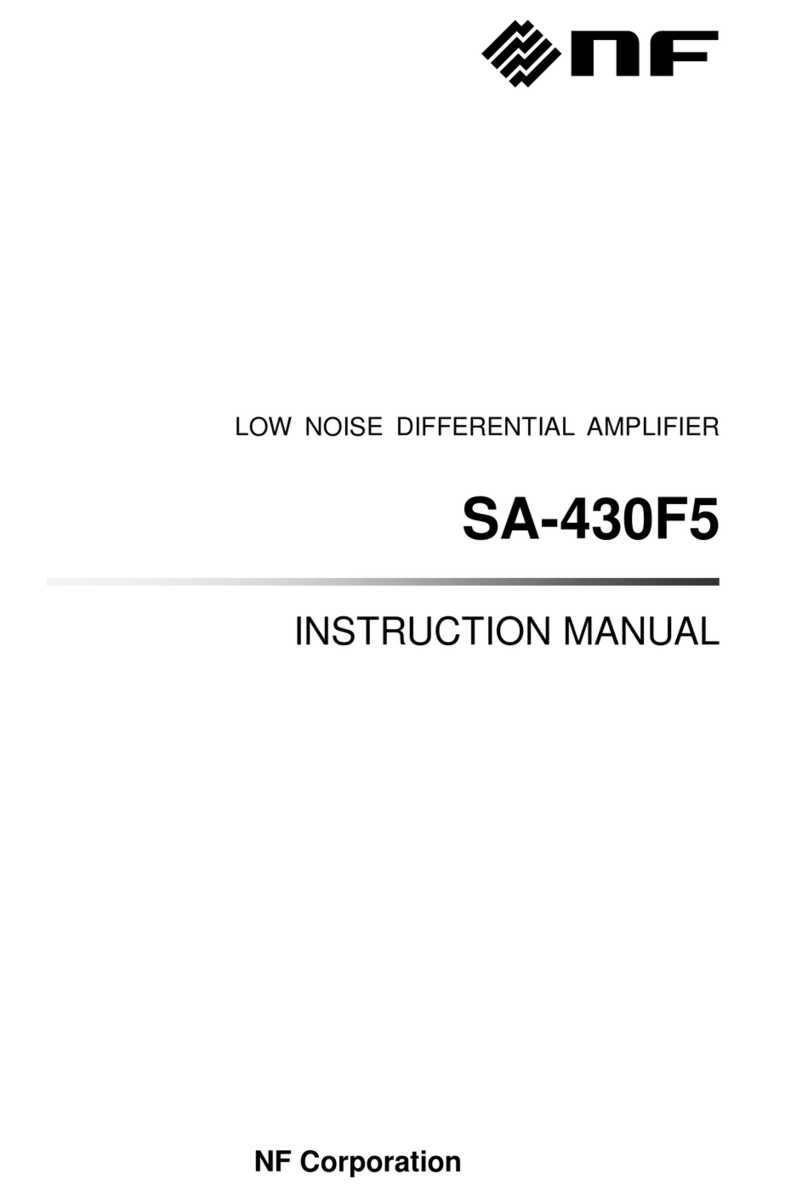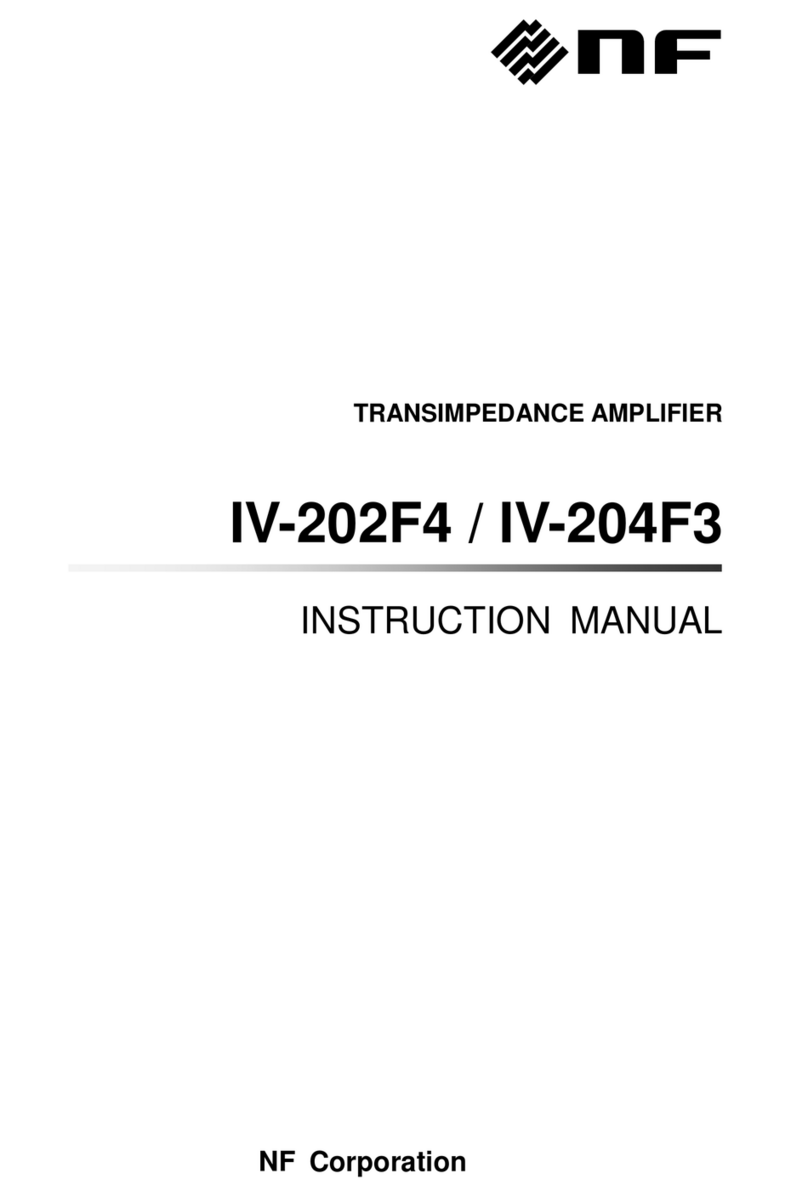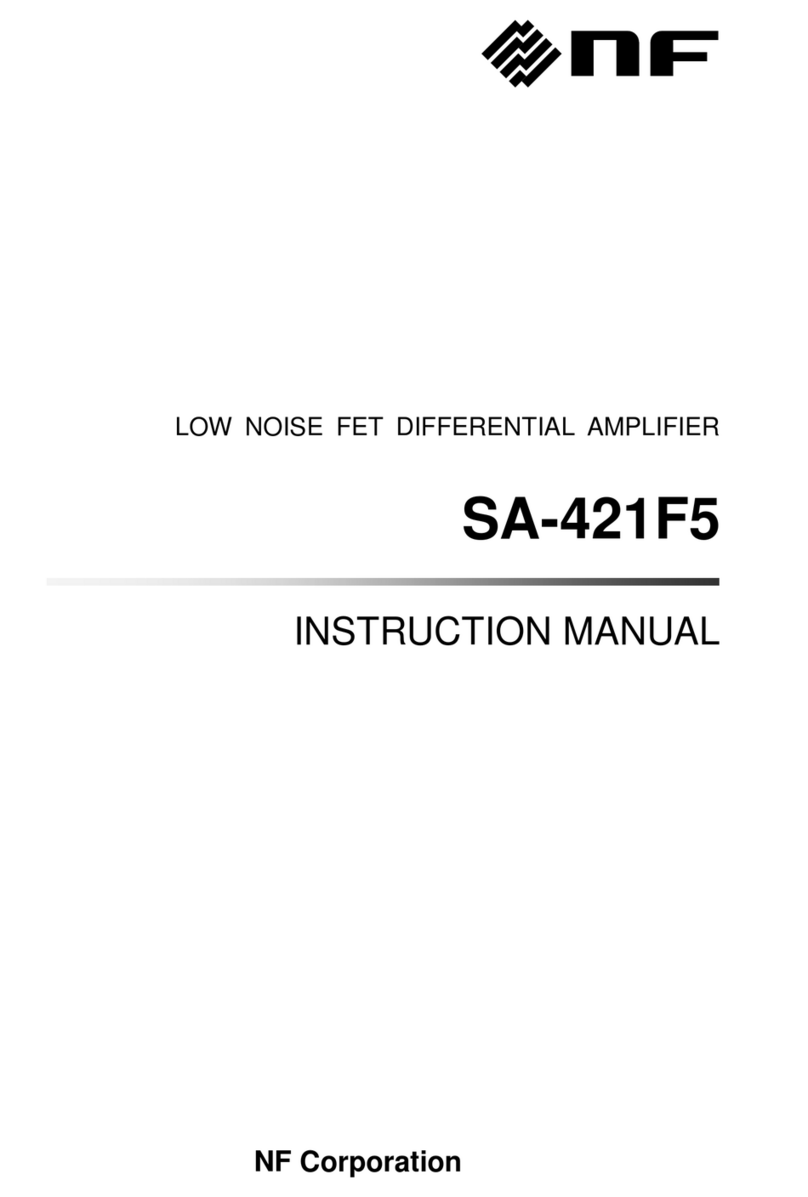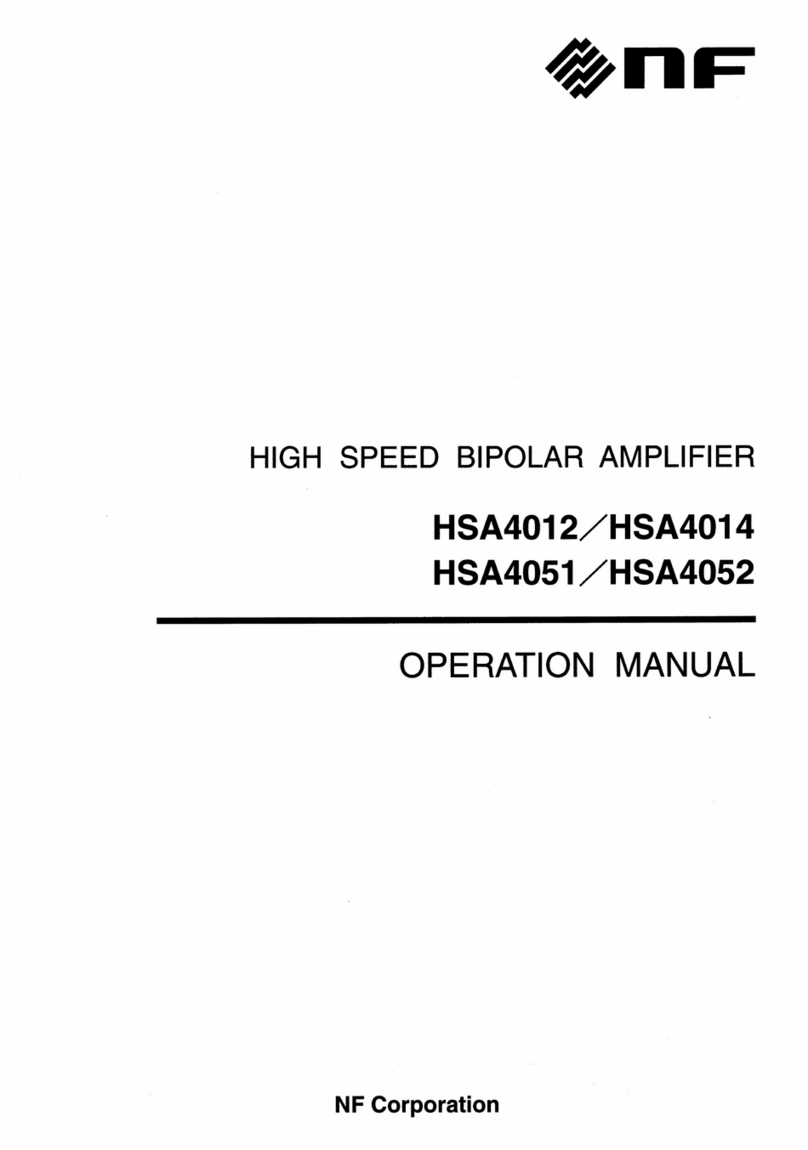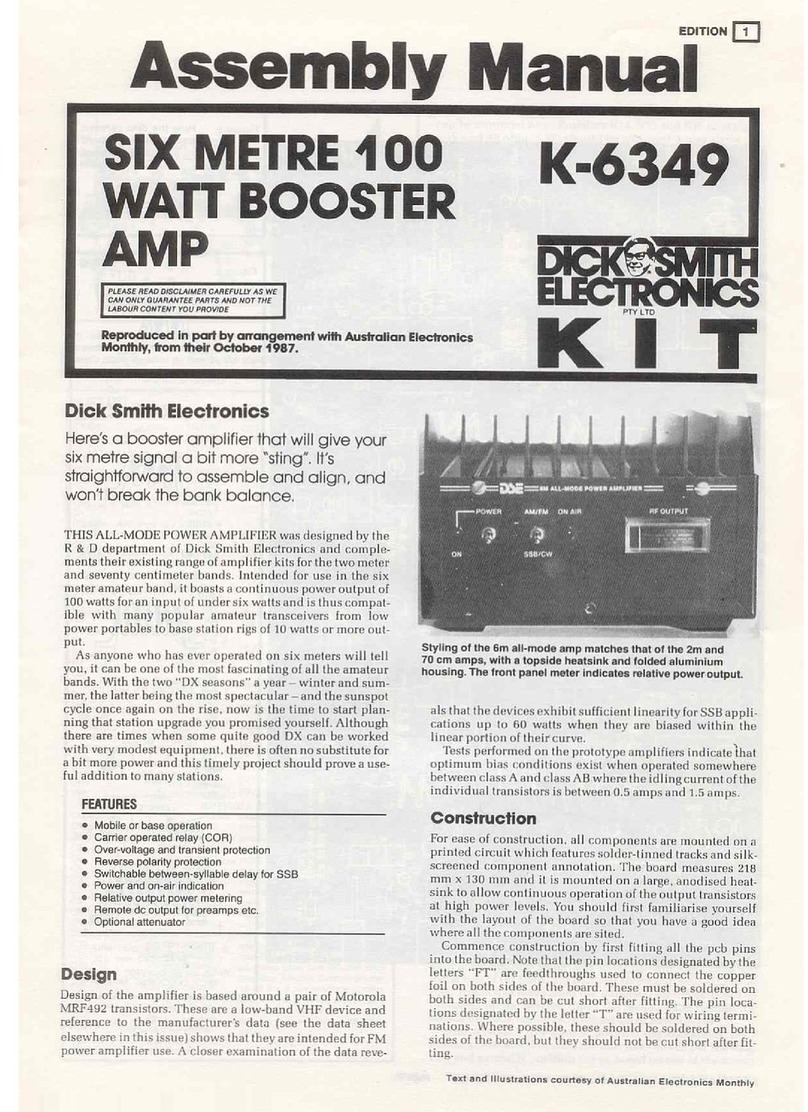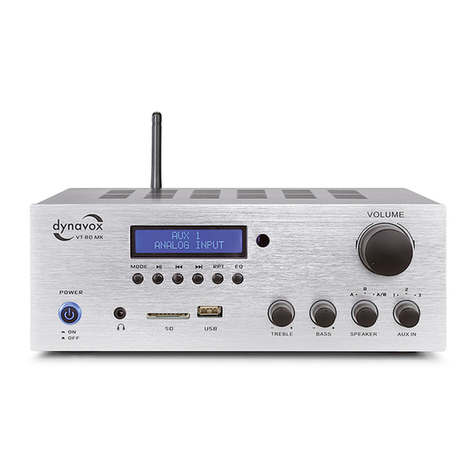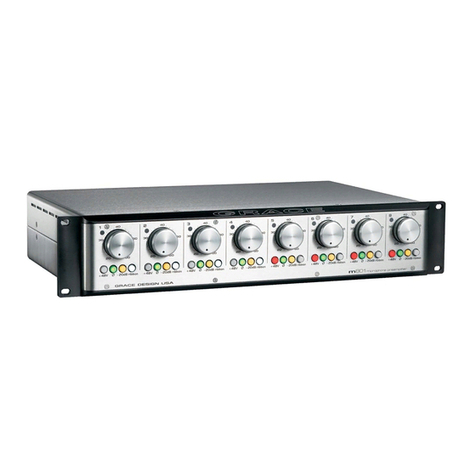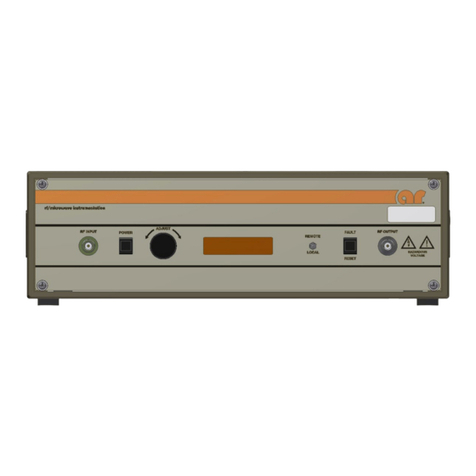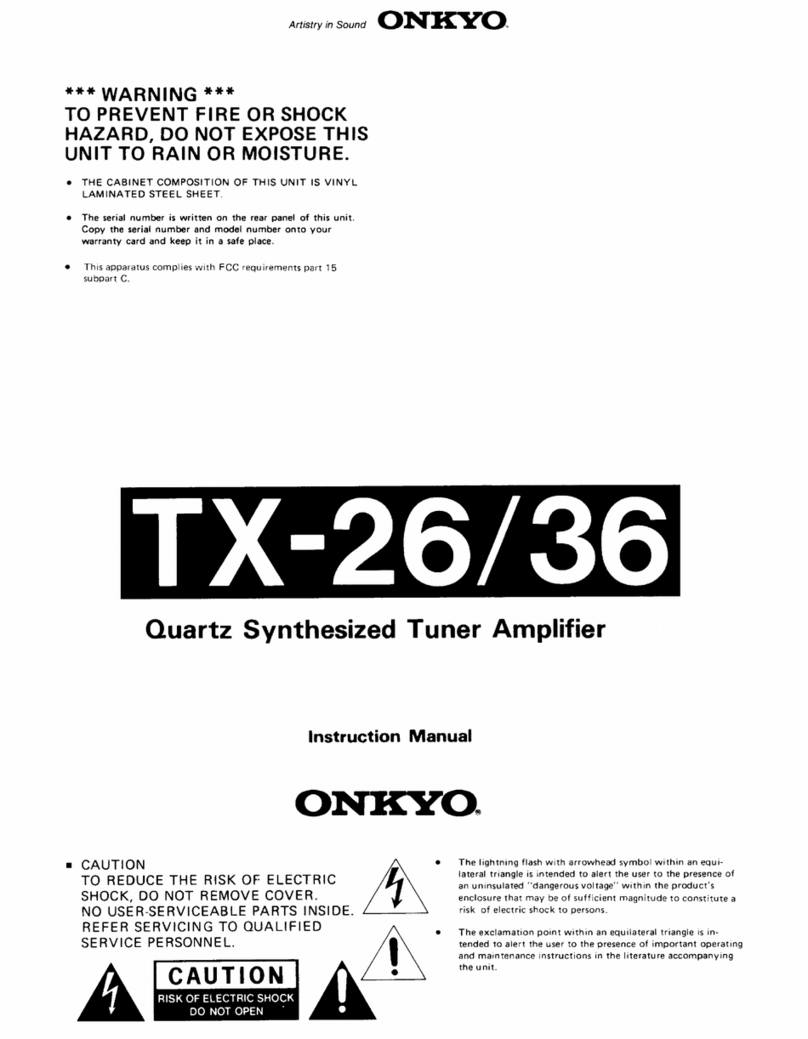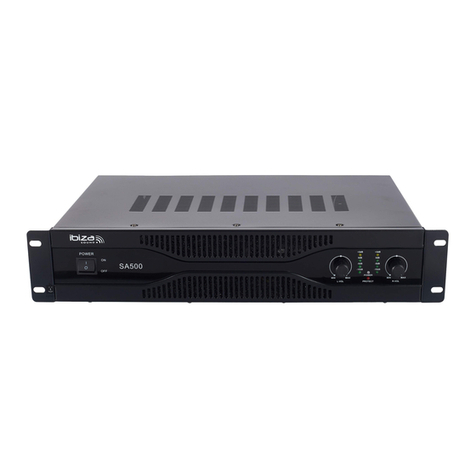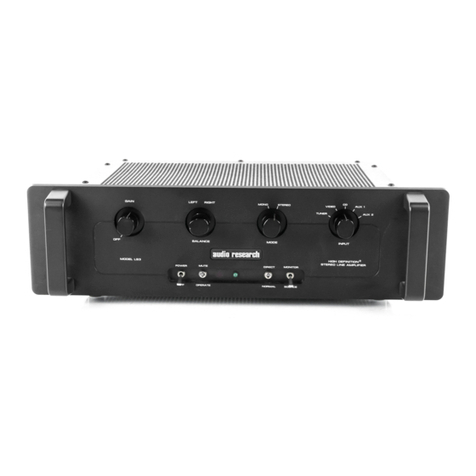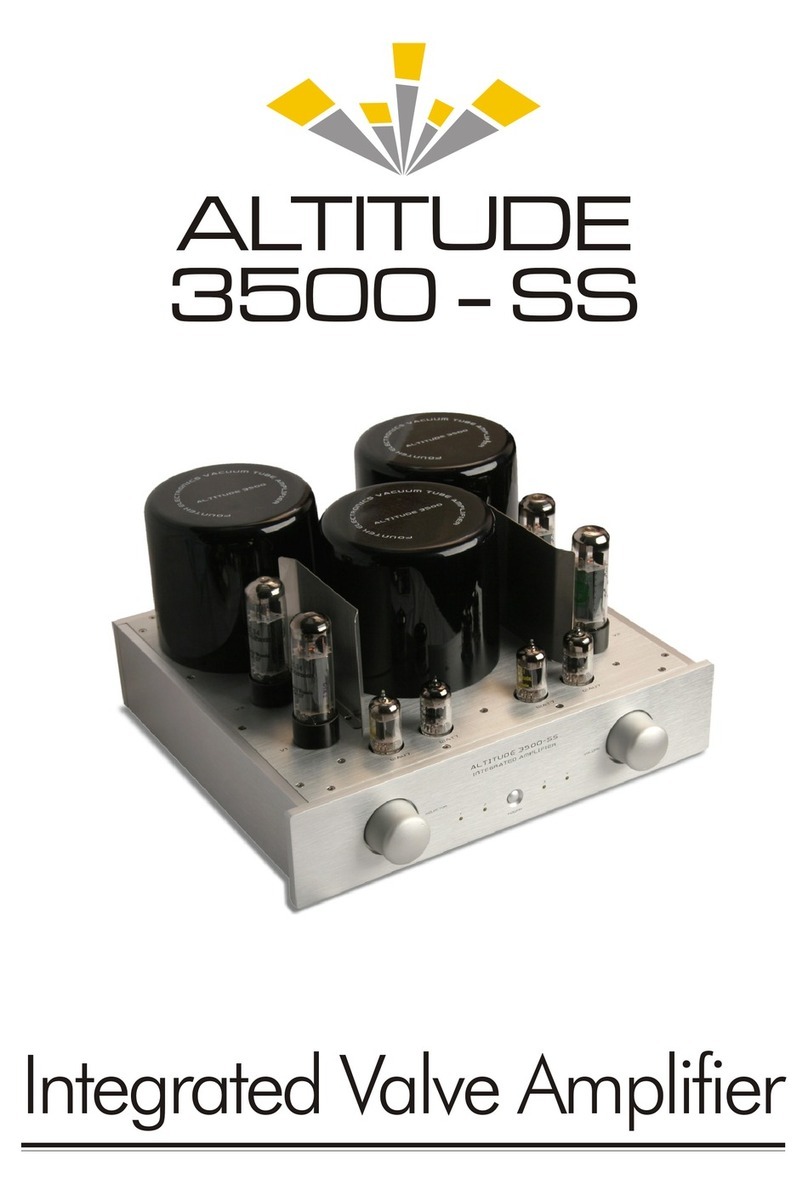NF HVA4321 User manual

INSTRUCTION MANUAL
NF Corporation
http://www.nfcorp.co.jp/
NF Corporation
6-3-20, Tsunashima-higashi, Kohoku-ku,Yokohama 223-8508 JAPAN
HVA4321
10kV AC/DC AMPLIFIER
HVA4321 10kV AC/DC AMPLIFIER


10kV AC/DC AMPLIFIER
HVA4321
Instruction Manual
DA00012063-001
This unit generates high voltage. Incorrect operation may result in death
or injury. To prevent death or injury, please read this manual carefully.
Keep this manual near the unit so that operators may read at any time.


HVA4321 i
!
⎯ Preface ⎯
Thank you for purchasing the 10 kV AC/DC amplifier.
To ensure safe and proper use of this electric equipment, please read first INSTRUCTIONS FOR SAFE
USE on the following pages.
Caution Symbols Used in This Manual
The following caution symbols are used in this manual. Be sure to observe these caution symbols and their
contents to ensure the safety of the user and avoid damage to the equipment.
This mark indicates information for the avoidance of a hazard such as electric shock that may endanger
human life or cause injury during handling of the equipment.
This mark indicates information for the avoidance of damage to the equipment during handling.
This manual has the following chapter organization.
If reading this manual for the first time, start from Chapter 1.
1. OVERVIEW
Describes various items that must be checked prior to using this product.
2. PREPARATIONS BEFORE USE
Describes various cautions regarding preparations to be made before installation or operation.
3. PART NAMES AND FUNCTIONS
Describes functions, movements and basic operations for knobs on the panel. Read this manual
while operating the unit.
4. OPERATION
Describes operation of this product.
5. REPRESENTATIVE CHARACTERISTICS
Describes representative characteristic of this product.
6. TROUBLESHOOTING
Describes corrective actions when problems occur.
7. MAINTENANCE
Describes basic operation tests and daily maintenance procedures.
8. SPECIFICATIONS
Lists the specifications (functions and performance).
!CAUTION
WARNING

HVA4321 ii
⎯Safety Precautions ⎯
To ensure safe use, be sure to observe the following warnings and cautions.
NF Corporation shall not be held liable for damages that arise from a failure to observe these warnings and
cautions.
This product is a Class 1 product (with protective conductor terminal) that conforms to the JIS and IEC
insulation standards.
Be sure to observe the contents of this instruction manual.
This instruction manual contains information for the safe operation and use of this product.
Be sure to read this information first before using this product.
All the warnings in the instruction manual must be heeded to prevent hazards that may cause major
accidents.
Be sure to ground the product.
This product uses a line filter and must be grounded to avoid the risk of electric shock.
To prevent electric shock, be sure to safely implement grounding according to Japanese Standard for
Electrical Equipment Technology D (Type 3) or higher.
When the 3-pin power plug is connected to the 3-pin power outlet with protective ground contact, this
product is automatically grounded.
To use 3-pin 2-pin conversion adapter, be sure to connect the ground line (green) of the conversion
adapter to the ground terminal near the outlet.
If the ground terminal is available at the back panel, the terminal may be grounded with a wire equivalent
to or larger than the thickness of the power cable.
Check the power supply voltage.
This product operates on the power supply voltage indicated in Grounding and Power Supply Connection
in this instruction manual.
Prior to connecting the power supply, check that the voltage of the power supply matches the rated power
supply of the product.
Observe the fuse rating.
Fire may occur. Use the rated fuse specified in Grounding and Power Supply Connection in the
instruction manual.
When the fuse is replaced, be sure to disconnect the power cable from the outlet.
In case of suspected anomaly
If this product emits smoke, an abnormal smell, or abnormal noise, immediately disconnect the power
cable and stop operation.
If such an anomaly occurs, do not use this product until it has been repaired, and immediately report the
problem to the location of purchase (either NF Corporation or your distributor).
Do not use this product when gas is present.
Otherwise, it may cause an explosion.

HVA4321 iii
!
!
!
Do not remove the cover.
This product contains high-voltage parts. Absolutely never remove its cover. Even when the inside of this
product needs to be inspected, do not touch the inside.
All such inspections are to be performed by service technicians designated by NF Corporation.
Do not modify this product.
Absolutely never modify this product, as this may cause new hazards and may disqualify this product
from repair in case of failure.
Safety-related symbols
The general definitions of the safety-related symbols used on this product and in the instruction manual
are provided below.
Instruction manual reference symbol
This symbol is displayed to alert the user to potential danger and refer him/her to
the instruction manual.
Electric shock danger symbol
This symbol indicates locations that present a risk of electric shock under specific
conditions.
Protective terminal grounding symbol
This symbol indicates terminals that require grounding to prevent electric shock.
Before operation of the unit, be sure to connect this terminal to the ground of type
3 or higher. (When the 3-pin power cable is connected to the 3-pin outlet, it is not
necessary to connect this ground terminal.)
Warning Symbol
This symbol indicates information for avoiding danger to human life or bodily
injury such as electric shock while handling this product.
Caution Symbol
This symbol indicates information for preventing damage to the product when
handling it.
Other symbols
This symbol indicates the "ON" position of the power switch.
This symbol indicates the "OFF" position of the power switch.
This symbol indicates that the external conductor of the connector is connected to the
case.
This symbol indicates that the external conductor of the connector is connected to the
signal ground.
CAUTION
WARNING

HVA4321 iv

HVA4321 v
Contents
Page
1. Overview
1.1 Features................................................................................................................. 1-1
1.2 Function description and block diagram ............................................................ 1-3
1.2.1 Function description .................................................................................................... 1-3
1.2.2 Block diagram............................................................................................................... 1-4
Preparations before use
2.1 Before using the HVA4321.................................................................................... 2-1
2.2 Installation............................................................................................................. 2-2
2.3 Grounding and power supply connection........................................................... 2-3
3. Nomenclature and functions
3.1 Signal system........................................................................................................ 3-1
3.1.1 Internal DC bias signal source..................................................................................... 3-1
3.1.2 External bias signal input ............................................................................................ 3-1
3.1.3 External signal input .................................................................................................... 3-2
3.1.4 Input signal ON/OFF ..................................................................................................... 3-2
3.2 Amplifier ................................................................................................................ 3-4
3.2.1 Amplifier operation mode ............................................................................................ 3-4
3.2.2 Amplifier control........................................................................................................... 3-6
3.2.3 Output ........................................................................................................................... 3-9
3.3 Monitor and control signal system .................................................................... 3-11
3.3.1 Monitor .........................................................................................................................3-11
3.3.2 Control signal system ................................................................................................ 3-12
3.4 Power supply items ............................................................................................ 3-17
3.5 Panel drawing ..................................................................................................... 3-18
3.5.1 Front panel.................................................................................................................. 3-18
3.5.2 Rear panel ................................................................................................................... 3-19
4. Operation method
4.1 Operation example in constant voltage mode .................................................... 4-1
4.1.1 Panel setting ................................................................................................................. 4-3
4.1.2 Connection of signal source and connection of load................................................. 4-6
4.1.3 Power supply and internal high voltage DC power supply......................................... 4-9
4.1.4 Signal output and adjustment.....................................................................................4-11
4.1.5 Signal OFF .................................................................................................................. 4-13
4.2 Operation example in constant current mode (total) ....................................... 4-14
4.2.1 Panel setting ............................................................................................................... 4-16
4.2.2 Connection of signal source and connection of load............................................... 4-19
4.2.3 Power supply and internal high voltage DC power supply....................................... 4-22
4.2.4 Signal output and adjustment.................................................................................... 4-24
4.2.5 Signal OFF .................................................................................................................. 4-26

Contents
HVA4321 vi
4.3 Operation example in constant current mode (load)........................................ 4-27
4.3.1 Panel setting ............................................................................................................... 4-29
4.3.2 Connection of signal source and connection of load............................................... 4-32
4.3.3 Power supply and internal high voltage DC power supply....................................... 4-35
4.3.4 Signal output and adjustment.................................................................................... 4-37
4.3.5 Signal OFF .................................................................................................................. 4-39
4.4 Operation example in constant current + constant voltage mode .................. 4-40
4.4.1 Panel setting ............................................................................................................... 4-42
4.4.2 Connection of signal source and connection of load............................................... 4-45
4.4.3 Power supply and internal high voltage DC power supply....................................... 4-48
4.4.4 Signal output and adjustment.................................................................................... 4-50
4.4.5 Signal OFF .................................................................................................................. 4-52
4.5 Change of load and power OFF ......................................................................... 4-53
4.5.1 Change of load ........................................................................................................... 4-53
4.5.2 Power supply OFF ...................................................................................................... 4-56
4.6 Remote control.................................................................................................... 4-57
4.6.1 Remote control ........................................................................................................... 4-57
4.6.2 Panel setting for use of remote control..................................................................... 4-58
5. Representative characteristics
5.1 Measuring method ................................................................................................ 5-1
5.2 Characteristics in constant voltage mode .......................................................... 5-3
5.2.1 Frequency characteristics ........................................................................................... 5-3
5.2.2 Step response............................................................................................................... 5-4
5.3 Characteristics in constant current mode .......................................................... 5-5
5.3.1 Frequency characteristics ........................................................................................... 5-5
5.3.2 Step response............................................................................................................... 5-6
5.4 Characteristics in constant current and constant voltage mode ...................... 5-7
5.4.1 Frequency characteristics ........................................................................................... 5-7
5.5 Characteristics of voltage monitor and current monitor ................................... 5-8
5.5.1 Frequency characteristics ........................................................................................... 5-8
5.6 Others .................................................................................................................... 5-9
5.6.1 Delay of output signal for input signal........................................................................ 5-9
5.6.2 Step response due to difference of amplitude .......................................................... 5-10
6. Troubleshooting
6.1 When suspecting a fault....................................................................................... 6-1
7. Maintenance
7.1 Daily maintenance ................................................................................................ 7-1
7.2 Inspection.............................................................................................................. 7-2
7.3 When the unit is not used for a long time........................................................... 7-2
7.4 Performance test................................................................................................... 7-3
7.4.1 Test of constant voltage mode..................................................................................... 7-3
7.4.2 Test of constant current mode..................................................................................... 7-4

Contents
HVA4321 vii
8. Specification
8.1 Signal area ............................................................................................................ 8-1
8.2 Amplifier ................................................................................................................ 8-2
8.2.1 Characteristics of constant voltage mode .................................................................. 8-2
8.2.2 Characteristics of constant current mode................................................................... 8-4
8.3 Output area............................................................................................................ 8-5
8.4 Monitor output ...................................................................................................... 8-5
8.5 Other input/output signal ..................................................................................... 8-6
8.6 Protection circuit .................................................................................................. 8-7
8.7 Others .................................................................................................................... 8-7
8.8 General items ........................................................................................................ 8-8

HVA4321 viii
Figures
Page
Figure1-1. HVA4321 Block diagram................................................................................................. 1-4
Figure2-1. Check of power OFF ...................................................................................................... 2-3
Figure2-2. Check of internal high voltage DC power OFF ............................................................. 2-3
Figure2-3. Inserting power cable connector................................................................................... 2-4
Figure2-4. Using conversion connector .........................................................................................2-4
Figure2-5. Casing ground terminal ................................................................................................. 2-5
Figure3-1. Internal DC bias signal source ...................................................................................... 3-4
Figure3-2. External DC bias input ................................................................................................... 3-1
Figure3-3. External signal input...................................................................................................... 3-2
Figure3-4. Signal ON/OFF switch .................................................................................................... 3-2
Figure3-5. Operation mode switch.................................................................................................. 3-4
Figure3-6. Limiter and response ..................................................................................................... 3-6
Figure3-7. Operation of voltage limiter (1) ..................................................................................... 3-6
Figure3-8. Operation of voltage limiter (2) ..................................................................................... 3-6
Figure3-9. Operation of current limiter........................................................................................... 3-7
Figure3-10. Response function in constant voltage mode .............................................................. 3-8
Figure3-11. Response function in constant current mode .............................................................. 3-8
Figure3-12. Output area..................................................................................................................... 3-9
Figure3-13. Power supply and internal high voltage DC power ...................................................... 3-9
Figure3-14. Return terminal ............................................................................................................ 3-10
Figure3-15. Monitor output...............................................................................................................3-11
Figure3-16. Status signal output......................................................................................................3-11
Figure3-17. Remote/local settings .................................................................................................. 3-12
Figure3-18. Remote control input ................................................................................................... 3-12
Figure3-19. Remote control input circuit........................................................................................ 3-13
Figure3-20. Remote control of HIGH VOLTAGE POWER SUPPLY ON/OFF ................................... 3-14
Figure3-21. Remote control of signal system ON/OFF .................................................................. 3-14
Figure3-22. Remote control of signal ON/OFF ............................................................................... 3-15
Figure3-23. Example of status contact output ............................................................................... 3-16
Figure4-1. Constant voltage mode (total mode) ............................................................................. 4-1
Figure4-2. Constant voltage mode (load mode) ............................................................................. 4-2
Figure4-3. Internal high voltage DC power OFF ............................................................................. 4-3
Figure4-4. Switch settings............................................................................................................... 4-3
Figure4-5. Output mode settings .................................................................................................... 4-4
Figure4-6. Local settings................................................................................................................. 4-4
Figure4-7. Limiter settings .............................................................................................................. 4-5
Figure4-8. Current monitor mode settings ..................................................................................... 4-5
Figure4-9. Response settings ......................................................................................................... 4-6
Figure4-10. Connection of external signal source signal ................................................................ 4-6

Figures
HVA4321 ix
Figure4-11. Connection of monitor................................................................................................... 4-7
Figure4-12. Connection of output cable ........................................................................................... 4-7
Figure4-13. Power supply.................................................................................................................. 4-9
Figure4-14. Internal high voltage DC power ON............................................................................. 4-10
Figure4-15. Using internal DC bias signal .......................................................................................4-11
Figure4-16. Using external oscillator.............................................................................................. 4-12
Figure4-17. Using external DC bias signal ..................................................................................... 4-12
Figure4-18. Total mode .................................................................................................................... 4-15
Figure4-19. Internal high voltage DC power OFF ........................................................................... 4-16
Figure4-20. Switch settings............................................................................................................. 4-16
Figure4-21. Output mode settings .................................................................................................. 4-17
Figure4-22. Local settings............................................................................................................... 4-17
Figure4-23. Limiter settings ............................................................................................................ 4-18
Figure4-24. Current monitor mode settings ................................................................................... 4-18
Figure4-25. Response settings ....................................................................................................... 4-19
Figure4-26. Connection of external signal source signal .............................................................. 4-19
Figure4-27. Connection of monitor................................................................................................. 4-20
Figure4-28. Connection of output cable ......................................................................................... 4-20
Figure4-29. Power supply................................................................................................................ 4-22
Figure4-30. Internal high voltage DC power ON............................................................................. 4-23
Figure4-31. Using internal DC bias signal ...................................................................................... 4-24
Figure4-32. Using external oscillator.............................................................................................. 4-25
Figure4-33. Using external DC bias signal ..................................................................................... 4-25
Figure4-34. Load mode.................................................................................................................... 4-28
Figure4-35. Internal high voltage DC power OFF ........................................................................... 4-29
Figure4-36. Switch settings............................................................................................................. 4-29
Figure4-37. Output mode settings .................................................................................................. 4-30
Figure4-38. Local settings............................................................................................................... 4-30
Figure4-39. Limiter settings ............................................................................................................ 4-31
Figure4-40. Current monitor mode settings ................................................................................... 4-31
Figure4-41. Response settings ....................................................................................................... 4-32
Figure4-42. Connection of external signal source signal .............................................................. 4-32
Figure4-43. Connection of monitor................................................................................................. 4-33
Figure4-44. Connection of output cable ......................................................................................... 4-33
Figure4-45. Power supply................................................................................................................ 4-35
Figure4-46. Internal high voltage DC power ON............................................................................. 4-36
Figure4-47. Using internal DC bias signal ...................................................................................... 4-37
Figure4-48. Using external oscillator.............................................................................................. 4-38
Figure4-49. Using external DC bias signal ..................................................................................... 4-38
Figure4-50. Constant current constant voltage mode (total mode)............................................... 4-41
Figure4-51. Constant current constant voltage mode (load mode) ............................................... 4-41
Figure4-52. Internal high voltage DC power OFF ........................................................................... 4-42
Figure4-53. Switch settings............................................................................................................. 4-42

Figures
HVA4321 x
Figure4-54. Output mode settings .................................................................................................. 4-43
Figure4-55. Local settings............................................................................................................... 4-43
Figure4-56. Limiter settings ............................................................................................................ 4-44
Figure4-57. Current monitor mode settings ................................................................................... 4-44
Figure4-58. Response settings ....................................................................................................... 4-45
Figure4-59. Connection of external signal source signal .............................................................. 4-45
Figure4-60. Connection of monitor................................................................................................. 4-46
Figure4-61. Connection of output cable ......................................................................................... 4-47
Figure4-62. Power supply................................................................................................................ 4-48
Figure4-63. Internal high voltage DC power ON............................................................................. 4-49
Figure4-64. Using internal DC bias signal ...................................................................................... 4-50
Figure4-65. Using external oscillator.............................................................................................. 4-51
Figure4-66. Using external DC bias signal ..................................................................................... 4-51
Figure4-67. Input signal OFF........................................................................................................... 4-53
Figure4-68. Internal high voltage power supply OFF ..................................................................... 4-53
Figure4-69. Checking items before power OFF .............................................................................. 4-54
Figure4-70. POWER OFF ................................................................................................................. 4-54
Figure4-71. Removing high voltage cable ...................................................................................... 4-55
Figure4-72. Remote control............................................................................................................. 4-57
Figure4-73. Remote control switch................................................................................................. 4-58
Figure5-1. Compensation of probe ................................................................................................. 5-1
Figure5-2. Measuring method of output voltage ............................................................................ 5-1
Figure5-3. Measuring method of output current ............................................................................ 5-2
Figure5-4. Frequency characteristics in constant voltage mode without load............................. 5-3
Figure5-5. Frequency characteristics in constant voltage mode with capacity load ................... 5-3
Figure5-6. Step response in constant voltage mode without load ................................................ 5-4
Figure5-7. Step response in constant voltage mode with 35 pF load ........................................... 5-4
Figure5-8. Frequency characteristics in constant current (TOTAL) mode.................................... 5-5
Figure5-9. Frequency characteristics in constant current (LOAD) mode ..................................... 5-5
Figure5-10. Step response in constant current mode with 1 MΩload ............................................. 5-6
Figure5-11. Frequency characteristics in constant current (TOTAL) + constant voltage mode .... 5-7
Figure5-12. Frequency characteristics in constant current (LOAD) + constant voltage mode...... 5-7
Figure5-13. Frequency characteristics of voltage monitor.............................................................. 5-8
Figure5-14. Frequency characteristics of current monitor.............................................................. 5-8
Figure5-15. Delay of input/output signal .......................................................................................... 5-9
Figure5-16. Step response in constant voltage mode.................................................................... 5-10
Figure7-1. How to remove fan cover ............................................................................................... 7-1
Figure7-2. Check method of constant voltage mode ..................................................................... 7-3
Figure7-3. Check method of constant current mode...................................................................... 7-4
Figure8-1. Output current................................................................................................................ 8-2
Figure8-2. Voltage and current range allowed for output .............................................................. 8-3

HVA4321 xi
Tables
Page
Table2-1. Accessories.................................................................................................................... 2-3
Table3-1. Logic of HIGH VOLTAGE POWER SUPPLY ON/OFF...................................................... 3-3
Table3-2. Logic of signal system ON/OFF signal ......................................................................... 3-3
Table3-3. Logic of SIGNAL ON/OFF signal.................................................................................... 3-3
Table3-4. Status contact output signal ......................................................................................... 3-3

Figures
HVA4321 xii

1. Overview
1.1 Features ・・・・・・・・・・・・・・・・・・・・・・・・・・・・・・・・・・・・・・・・・1-1
1.2 Function description and block diagram ・・・・・・・・・・・・・・1-3
1.2.1 Function description・・・・・・・・・・・・・・・・・・・・・・・・・・・1-3
1.2.2 Block diagram ・・・・・・・・・・・・・・・・・・・・・・・・・・・・・・・・1-4

HVA4321 1-2

1.1 Features
HVA4321 1-1
1.1 Features
The HVA4321 10 kV AC/DC amplifier is a constant voltage/constant current amplifier capable of
±10 kVpk and ±10 mApk.
Since the unit has a DC bias signal source, it can be used as a DC power supply that is individually
capable of high voltage output. Since external AC signal and DC signal input are allowed, it can
also be used as an amplifier capable of high voltage output.
Constant voltage/constant current amplifier
The unit can be used as a constant voltage amplifier or a constant current amplifier.
The unit can also be set as a constant voltage amplifier for DC signal and a constant
current amplifier for AC signal.
Built-in DC signal source
The unit has a built-in DC bias signal source.
With external signal input terminals
The unit can be connected to the external signal source for two systems.
Excellent characteristics with large amplitude
In constant voltage mode, 10 kVpk output up to 7 kHz is available.
In constant current mode, 10 kVpk output up to 4 kHz is available.
(with resistance load for both modes)
With output limiter function
Output voltage limiter and output current limiter functions are available.
High slew rate
In the constant voltage amplifier, the slew rate of 500 V/Ωis achieved.
Two types of current mode
In the constant current amplifier, two types of modes are available; the total mode that gives the
set current output from the amplifier and the load mode that gives correct current set to the load
by compensating the current leaking from stray capacitance of a wire along the path.
Step response waveform adjusting function
For a step signal, fine adjustment of the response waveform can be made.
Correct monitor output
Output voltage and output current can be correctly monitored.
(Voltage monitor gain: 1/1000, Current monitor gain: 1 V/10 mA)

1.1 Features
HVA4321 1-2
Visual display of high voltage output
During high voltage output, the LED around the output connector lights and the revolution
changes depending on the output voltage level.
Remote control is capable.
Signals can be turned ON/OFF with an external control signal.
Table of contents
Other NF Amplifier manuals
